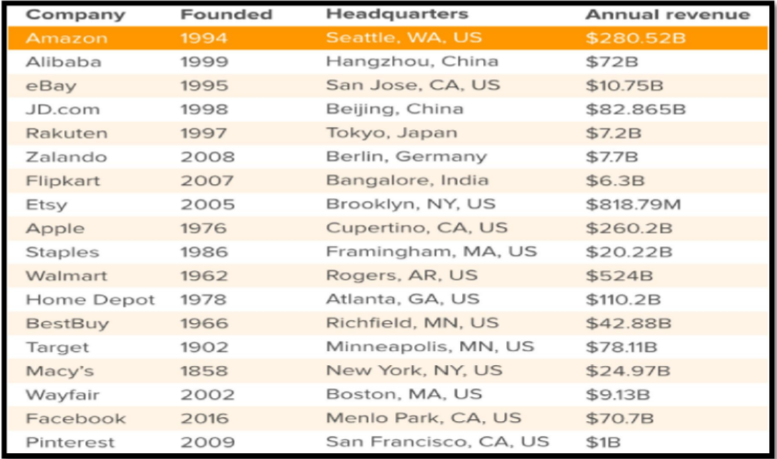Introduction
Organizational performance and the overall success of a company in a given market depend on a variety of factors. In particular, the achievement of competitive advantage is based on the company structure, management, human resources, assets, developments, and marketing, which collectively impact the opportunities for a firm’s achievement of its goals. Amazon.com Inc. is a large international company that has gained significant growth levels and competitive advantage over its rivals in the e-commerce sector, the performance of which is subject to analysis. This paper examines Amazon’s key organizational features and developments to identify the factors that have shaped its competitive dominance and leading position in the industry.
Company Overview
Amazon.com, Inc. operates in the industry of e-commerce, selling a variety of goods to its customers around the world. Having first originated as a book store, the company has developed into an internet-based organization operating in the sectors of goods selling, information service delivery, online advertising, and web services (“Form 10-K” 3). The company’s vision is to become “Earth’s most customer-centric company” (“Form 10-K” 3). Amazon.com functions as an online store where millions of retailers sell their products to customers globally. The company has proved its status as a highly competitive entity in its industry. However, it faces rivals in such sectors as brick-and-mortar stores and e-commerce retailers selling a wide range of goods from grocery to electronics, web-search engines, publishers, advertising companies, and others (“Form 10-K” 3-4). Thus, having achieved successful results in terms of its growth and performance, Amazon seeks to maintain its leading position in the market.
Management
One of the factors that have contributed to Amazon’s competitive advantage is its company management. In particular, as stated in the company’s annual report, it functions according to four main principles of operations. They include “customer obsession rather than competitor focus, passion for invention, commitment to operational excellence, and long-term thinking” (“Form 10-K” 3). The company has a hierarchical structure with Jeffery Bazos as the Executive Chair. Given its structure, the management of business operations across the segments is conducted linearly under the central mission of serving customer needs based on their demand (Baboolal-Frank 1-2). Therefore, a well-defined customer-centered strategy coupled with a comprehensive hierarchical structure allows Amazon to achieve its goals efficiently.
Finance
Financial outcomes are one of the most significant factors that demonstrate the success or failure of a company based on its performance. In the case of Amazon, its financial stability has enhanced over the years of the firm’s operations. Indeed, as demonstrated in Figure 1, its annual revenue rate has steadily grown since 2014 (Alshmrani 73). Moreover, the speed of the current annual revenue of the company is the highest among its competitors (see Figure 2). Indeed, it now reaches $280,52B, indicating that the organization earns sufficient assets to expand and maintain its competitive advantage in the future (Alshmrani 79). Thus, the examination of Amazon’s finances has revealed another strong side of the company that contributes to its dominance in the industry of e-commerce.


Marketing
Another important factor in Amazon’s performance is its marketing strategy. The company invests significantly in its marketing operations since it prioritizes this segment, among others. According to the company’s official statements, the expanses on marketing in 2021 were $32,551 million, while in 2020, the company spent $22,008 million on marketing operations (“Form 10-K” 25). Importantly, a decisive element in the successful marketing strategy of Amazon is its advertising business which allows for promoting in-house brands in its stores. According to O’Reilly and Stevens, “while Amazon has rapidly expanded into a number of new businesses in recent years, including groceries, entertainment, and pharmaceuticals, its ad business has grown organically into a high-margin business” (1). Thus, the company diversifies its business segments, engages in online marketing campaigns through extensive SEO engagement, as well as uses external advertisement (Alshmrani 82). Figure 3 illustrates Amazon’s marketing channels and the tools the company uses to succeed in its marketing campaigns.

Entrepreneurship
As stated above, Amazon functions as a web-based store that allows multiple retailers to sell on its platform. Therefore, the concept of entrepreneurship is essential for the company’s business model. In particular, “almost 60% of the sales of physical products sold in the Amazon store (by value) are now made by independent sellers – entrepreneurs and other mostly small- and medium-sized businesses – not Amazon” (“Zero to 60” para. 3). In such a manner, the company engages small and medium-sized organizations and individual sellers to retailing operations on its website, thus fostering the development of small business in the USA and beyond. The prioritization of entrepreneurship aligns with the customer-centered business strategy since the “expanded selection and choice provided by independent sellers made a better shopping experience for customers” (“Zero to 60” para. 12). Thus, such an approach is beneficial for the company, small retailers, and consumers.
Human Resource Management
In the contemporary competitive business environment, human resources are particularly valued due to talent’s role as a driving force of progress and innovation. According to Amazon’s official statement, its human capital is essential for the company’s accomplishment of its mission and vision. The organization employs 1,608,000 employees, as well as uses “independent contractors and temporary personnel to supplement our workforce” (“Form 10-K” 4). In the workforce market, the company competes with its rivals over talents in such professions as software engineering, computer science, and other technical specializations (“Form 10-K” 4). Since the company strives to be a competitive employer, it focuses on “investment and innovation, inclusion and diversity, safety, and engagement to hire and develop the best talent” (“Form 10-K” 4). A well-structured system of career development and training programs are available to employees in order to ensure their professional growth, engagement, commitment, and loyalty to the company in a long-term perspective.
Research and Development
Since Amazon operates in a web service and e-commerce industry sector, its investment in research and development plays a crucial role in driving its competitive advantage. The company invests in “the research and development of new and existing products and services, development, design, and maintenance of our stores, curation, and display of products and services made available in our online stores” (“Form 10-K” 26). The dependence of the whole operations of Amazon advertising requires prioritization of innovative solutions, which is why talent in technological and technical professions is hired and developed (“Form 10-K” 4-5). Thus, the attention of Amazon.com, Inc. to its research and development expenses and technological advancement in its operational solutions allows for achieving a high level of performance excellence and competitive advantage.
Corporate Social Responsibility
Another significant aspect of any contemporary business performance is corporate social responsibility which entails the practices and strategies of a company aimed at addressing environmental issues, diversity, inclusion, and equity. In the case of Amazon, corporate social responsibility is manifested through a variety of interventions and initiatives, as well as company culture components. In particular, according to the company’s website, it prioritizes sustainable operations across its supply chain through waste minimization, decarbonization of production, and others (“Sustainable Operations”). Apart from minimizing emissions and waste from production, the company ensures that 50% of its shipments are net-zero carbon, partners with sustainable businesses, invest in global and local environmental initiatives, and uses renewable energy (“Sustainable Operations”). Thus, such a responsible sustainability-focused strategy allows the organization to contribute to environmental protection and social justice.
Conclusion
In conclusion, the overview of Amazon.com, Inc.’s business has demonstrated that the company has achieved its competitive advantage over its rivals in the e-commerce and web service industry through its business model and innovative solutions. Firstly, the company’s hierarchical structure and linear management align with the vision of becoming a customer-centered organization, allowing Amazon to serve consumers according to their demands. Secondly, a thought-through marketing strategy that involves internal and external marketing channels and is based on in-house advertising tools helps the company reach its consumers and increase their number and loyalty. Thirdly, the company prioritizes human resource management and research and development to enhance its technological competitive advantage. Finally, the investment into sustainable operations facilitates Amazon’s contribution to the green economy and boosts its reputation as a progressive company.
Works Cited
Alshmrani, Hatem Mohammed. “An Analytical View of Amazon Success in the Worldwide.” Life Science Journal, vol. 18, no. 6, 2021, pp. 71-90.
Baboolal-Frank, Rashri. “Analysis of Amazon: Customer-centric Approach.” Academy of Strategic Management Journal, vol. 20, 2021, pp. 1-16.
“Form 10-K.” Security and Exchange Commission, 2021, Web.
O’Reilly, Lara and Laura Stevens. “Amazon, with Little Fanfare, Emerges as an Advertising Giant.” The Wall Street Journal, Web.
“Sustainable Operations.” Amazon.com, 2022, Web.
“Zero to 60: The Acceleration of Independent Sellers in Our Store.” Amazon.com, Web.
